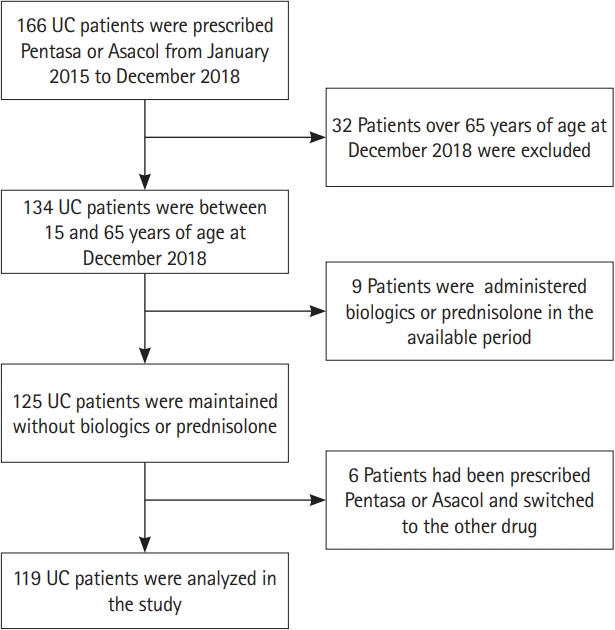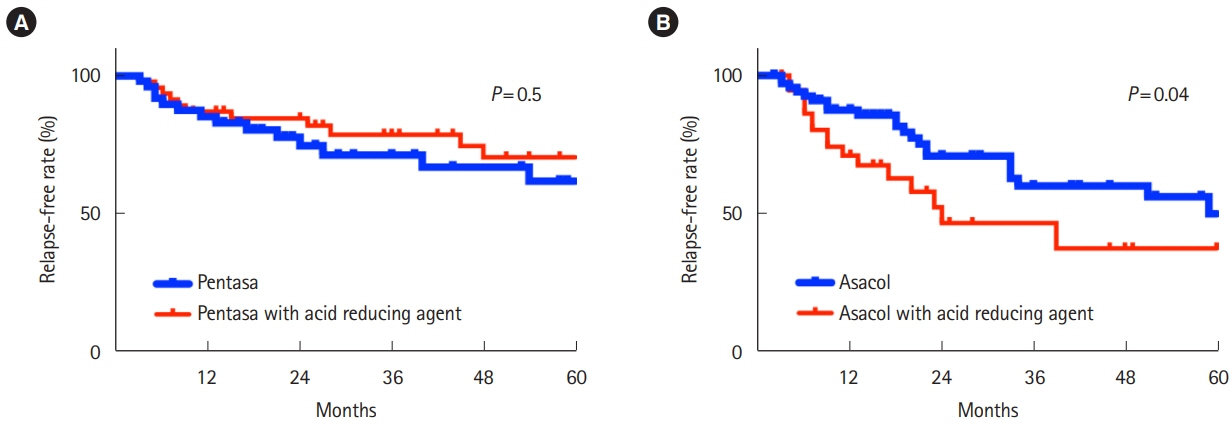Intest Res.
2021 Apr;19(2):225-231. 10.5217/ir.2020.00023.
Effect of acid-reducing agents on clinical relapse in ulcerative colitis with pH-dependent-released 5-aminosalicylic acid: a multicenter retrospective study in Japan
- Affiliations
-
- 1Department of Gastroenterology and Neurology, Akita University Graduate School of Medicine, Akita, Japan
- 2Division of Gastroenterology, Omagari Kosei Medical Center, Daisen, Japan
- KMID: 2515481
- DOI: http://doi.org/10.5217/ir.2020.00023
Abstract
- Background/Aims
5-Aminosalicylic acid (5-ASA) is a basic drug for inducing and maintaining remission for ulcerative colitis. One of its formulations has a coating with a pH-dependent degradation that ensures the release 5-ASA at the terminal ileum. No evidence has been shown concerning the effects of proton pump inhibitors (PPIs) or H2 receptor antagonists (H2RAs) on the clinical course of ulcerative colitis patients in remission. The present study assessed the effect of PPIs or H2RAs on the relapse of ulcerative colitis patients in clinical remission maintained by pH-dependent released 5-ASA.
Methods
Ulcerative colitis patients who had been prescribed time- or pH-dependent-released 5-ASA between January 2015 and December 2018 were enrolled in this multicenter retrospective study. The period of remission until relapse occurred was analyzed among the patients taking time-dependent-released 5-ASA or pH-dependent-released 5-ASA with/without PPIs or H2RAs.
Results
One hundred and nineteen patients were analyzed in this study. In the primary endpoint, the relapse rate was higher in patients taking pH-dependent-released 5-ASA and PPIs or H2RAs than in those taking the pH-dependent-released 5-ASA without PPIs or H2RAs, while the relapse rate was similar in patients taking the time-dependent-released 5-ASA with or without PPIs or H2RAs concomitantly. Patients with a short duration of disease and middle-aged patients more frequently showed relapse with PPIs or H2RAs than the other patients.
Conclusions
The coadministration of PPIs or H2RAs affects the clinical course of ulcerative colitis in remission maintained by pH-dependent-released 5-ASA.
Figure
Reference
-
1. Kaplan GG, Ng SC. Understanding and preventing the global increase of inflammatory bowel disease. Gastroenterology. 2017; 152:313–321.
Article2. Jeong DY, Kim S, Son MJ, et al. Induction and maintenance treatment of inflammatory bowel disease: a comprehensive review. Autoimmun Rev. 2019; 18:439–454.
Article3. Ungaro R, Mehandru S, Allen PB, Peyrin-Biroulet L, Colombel JF. Ulcerative colitis. Lancet. 2017; 389:1756–1770.
Article4. Burger D, Travis S. Conventional medical management of inflammatory bowel disease. Gastroenterology. 2011; 140:1827–1837.
Article5. Irvine EJ, Yeh CH, Ramsey D, Stirling AL, Higgins PD. The effect of mesalazine therapy on quality of life in patients with mildly and moderately active ulcerative colitis. Aliment Pharmacol Ther. 2008; 28:1278–1286.
Article6. Buckland A, Bodger K. The cost-utility of high dose oral mesalazine for moderately active ulcerative colitis. Aliment Pharmacol Ther. 2008; 28:1287–1296.
Article7. Frieri G, Giacomelli R, Pimpo M, et al. Mucosal 5-aminosalicylic acid concentration inversely correlates with severity of colonic inflammation in patients with ulcerative colitis. Gut. 2000; 47:410–414.
Article8. Abinusawa A, Tenjarla S. Release of 5-aminosalicylic acid (5-ASA) from mesalamine formulations at various pH levels. Adv Ther. 2015; 32:477–484.
Article9. Verdú EF, Armstrong D, Idström JP, et al. Effect of curing Helicobacter pylori infection on intragastric pH during treatment with omeprazole. Gut. 1995; 37:743–748.
Article10. Labenz J, Tillenburg B, Peitz U, et al. Helicobacter pylori augments the pH-increasing effect of omeprazole in patients with duodenal ulcer. Gastroenterology. 1996; 110:725–732.
Article11. Hamlet A, Olbe L. The influence of Helicobacter pylori infection on postprandial duodenal acid load and duodenal bulb pH in humans. Gastroenterology. 1996; 111:391–400.
Article12. Miner PB Jr, Allgood LD, Grender JM. Comparison of gastric pH with omeprazole magnesium 20.6 mg (Prilosec OTC) o.m. famotidine 10 mg (Pepcid AC) b.d. and famotidine 20 mg b.d. over 14 days of treatment. Aliment Pharmacol Ther. 2007; 25:103–109.
Article13. Hussain FN, Ajjan RA, Moustafa M, Weir NW, Riley SA. Mesalazine release from a pH dependent formulation: effects of omeprazole and lactulose co-administration. Br J Clin Pharmacol. 1998; 46:173–175.
Article14. Wiltink EH, Mulder CJ, Stolk LM, Rietbroek R, Verbeek C, Tytgat GN. Absorption of oral mesalazine-containing preparations and the influence of famotidine on the absorption. Scand J Gastroenterol. 1990; 25:579–584.
Article15. Barros LL, Farias AQ, Rezaie A. Gastrointestinal motility and absorptive disorders in patients with inflammatory bowel diseases: prevalence, diagnosis and treatment. World J Gastroenterol. 2019; 25:4414–4426.
Article16. Iijima K, Sekine H, Koike T, Imatani A, Ohara S, Shimosegawa T. Serum pepsinogen concentrations as a measure of gastric acid secretion in Helicobacter pylori-negative and -positive Japanese subjects. J Gastroenterol. 2005; 40:938–944.
Article17. Iijima K, Koike T, Abe Y, Ohara S, Nakaya N, Shimosegawa T. Time series analysis of gastric acid secretion over a 20-year period in normal Japanese men. J Gastroenterol. 2015; 50:853–861.
Article18. Bello C, Belaiche J, Louis E, Reenaers C. Evolution and predictive factors of relapse in ulcerative colitis patients treated with mesalazine after a first course of corticosteroids. J Crohns Colitis. 2011; 5:196–202.
Article19. Haruma K, Mihara M, Okamoto E, et al. Eradication of Helicobacter pylori increases gastric acidity in patients with atrophic gastritis of the corpus-evaluation of 24-h pH monitoring. Aliment Pharmacol Ther. 1999; 13:155–162.
Article20. Martin TD, Chan SS, Hart AR. Environmental factors in the relapse and recurrence of inflammatory bowel disease: a review of the literature. Dig Dis Sci. 2015; 60:1396–1405.
Article
- Full Text Links
- Actions
-
Cited
- CITED
-
- Close
- Share
- Similar articles
-
- 5-aminosalicylic acid in the management of ulcerative colitis
- 5-Aminosalicylic Acid-induced Myocarditis in a Patient with Atypical Ulcerative Colitis
- A Case of Acute Pancreatitis Caused by 5-aminosalicylic Acid Suppositories in a Patient with Ulcerative Colitis
- 5-Aminosalicylic acid aggravates colitis mimicking exacerbation of ulcerative colitis
- Efficacy and safety of two pH-dependent-release mesalamine doses in moderately active ulcerative colitis: a multicenter, randomized, double-blind, parallel-group study




